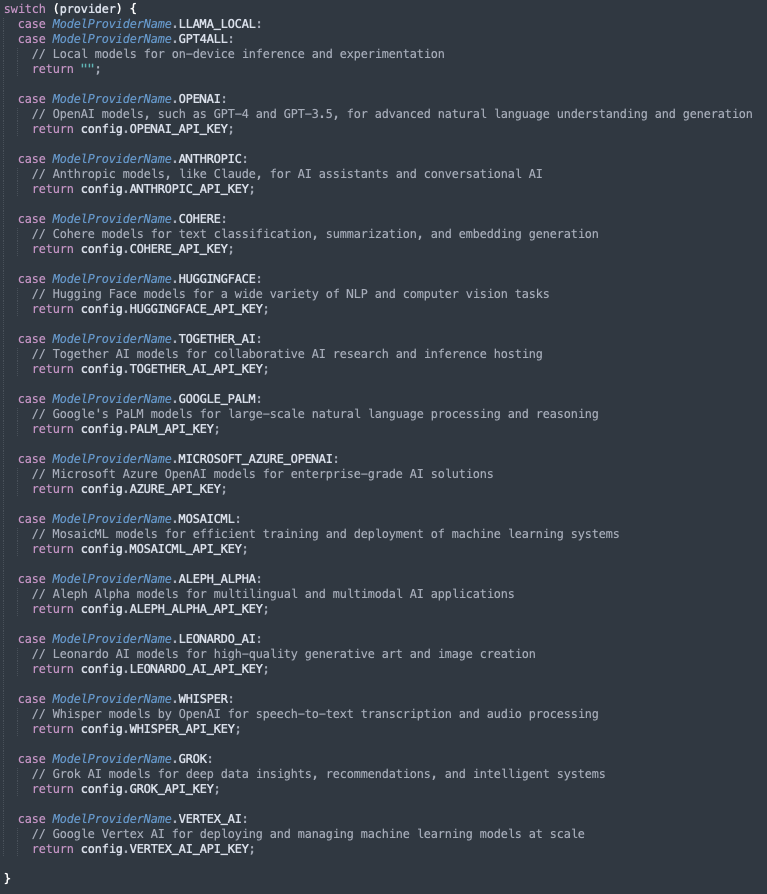Creating artificial intelligence (AI) agents is a process that requires careful planning and strategic decision-making, including choosing the right model provider. Depending on the specifics of the project, required features, and budget, different platforms offer unique possibilities. In this article, we’ll explore the key aspects of selecting an AI model provider and how to approach this challenge.

Why Is Choosing a Model Provider So Important?
The AI model is the heart of every artificial intelligence agent. It determines the system’s ability to understand language, process data, and generate results. Selecting the right provider impacts:
- Quality of responses: Models vary in their ability to generate natural, accurate answers.
- Range of features: Some providers specialize in specific areas, such as NLP, computer vision, or data classification.
- Costs: Licensing and infrastructure vary depending on the provider.
Key AI Model Providers and Their Applications
Local Models (LLAMA, GPT4ALL)
- Application: For testing and running on local devices.
- Advantages: No need for API keys, greater control over data.
- Limitations: Usually less efficient than cloud-based models.
OpenAI (GPT-4, GPT-3.5)
- Application: Advanced natural language processing (NLP), chatbots, text generation.
- Advantages: Excellent quality of generated responses and versatility.
- Limitations: Higher costs, requires an API key.
Anthropic (Claude)
- Application: Creating conversational assistants.
- Advantages: Strong focus on AI safety and ethics.
- Limitations: Less popular compared to OpenAI.
Hugging Face
- Application: A variety of tasks, from NLP to computer vision.
- Advantages: A wide range of open-source models and customization options.
- Limitations: Requires advanced technical knowledge.
Google (PaLM, Vertex AI)
- Application: Scalable language processing and machine learning systems.
- Advantages: Integration with other Google services, high scalability.
- Limitations: Often requires advanced cloud resources.
Microsoft Azure OpenAI
- Application: Enterprise solutions.
- Advantages: Integration with the Microsoft ecosystem.
- Limitations: Requires familiarity with the Azure platform.

When Should You Choose a Particular Provider?
Local vs. Cloud-Based Models
If data privacy or a limited budget is your priority, local models like LLAMA might be a good fit. However, for complex projects requiring significant computing power, cloud-based models are often more suitable.
Specific Business Needs
- NLP and Chatbots: OpenAI, Anthropic.
- Computer Vision: Hugging Face, Stability AI.
- Multimodality: Google PaLM, Aleph Alpha.
Budget and Infrastructure
Some platforms offer open-source models, but their implementation requires more technical effort. Commercial models like OpenAI provide ready-made solutions but are more expensive.
Key Steps in the Provider Selection Process
- Define the project goal: Is it about creating a chatbot, data analysis, or image recognition?
- Analyze available models: Choose the model that best meets functional requirements.
- Evaluate costs: Consider licensing fees and infrastructure expenses.
- Prototype testing: Test your chosen model on sample data.
- Scaling and deployment: Implement the solution with future scaling needs in mind.
The Future and Prospects for AI Agents
AI agents are developing rapidly, and their capabilities continue to grow. Choosing the right model provider is the foundation of any project’s success. Key trends include greater model personalization, increased openness in AI, and integrating multiple functions into a single ecosystem.

Summary
Selecting an AI model provider is a crucial step in creating AI agents. This decision affects functionality, cost, and the potential for future project development. A suitable approach involves analyzing the available options, defining business objectives, and testing chosen solutions. This way, it’s possible to create AI agents that effectively fulfill their tasks, regardless of the industry.
Get in Touch with CodeFormers
We are always ready for cooperation and new challenges. Contact us to learn more about our services, projects, and opportunities.

